‘No specific reason’ why maximum of six chosen as limit for social gatherings, minister says

UK to enter new phase of lockdown rules on Monday
Restrictions mean people can meet in maximum of groups of six
UK minister says ‘no specific reason’ six was chosen
Boris Johnson has confirmed new, wide-ranging restrictions on social gathering following a steep rise in coronavirus cases across the UK.
Unveiling his “alternative plan” on Wednesday, which he hopes will help life to return to closer to normality in time for Christmas, the prime minister announced the number of people that can attend social gatherings will be slashed to six in England from Monday.
That means, from next week, gatherings of more than six people will be illegal.
Johnson repeated the “rule of 6” phrase throughout the press conference, and now a senior member of the UK government has admitted there was no “specific” reason why six was chosen for the social gatherings rule.
Watch: All you need to know from the Government's latest coronavirus briefing
Read more: 13 exemptions when you can still meet up in groups of more than 6
The maximum number of six meeting indoors or outside has proven controversial, with many critics pointing out it means, for example, that a family of five will only be able to meet up with one grandparent at a time.
Asked about the reasoning behind the figure, transport secretary Grant Shapps told the BBC: “We had some pretty extensive discussions with the chief medical officer and the chief scientific officer advising us on this.
“There isn’t, to answer your question… it’s not that we looked around the world and we found ‘ah, this country has used a specific number’.
Have your say
“Countries do use different numbers and then overlay different types of rules. The one thing we know is the more that people do mix, the more the virus will spread.
“We’ve got to balance that against people being able to practically go about their lives. We don’t want there to be a second lockdown, that’s not what this, what we want to do is avoid that.
“And the rule of six we found is likely to be the right balance between the two based on the advice from people like the chief medical officer, but I don’t want to pretend there’s some magic solution to any of this.”
Outlining the rules further, he said six was “a pragmatic number”.
He said: “Six is a pragmatic number because it is the foundation of a number that people will recognise – we’ve had this rule of six in a slightly different form before.”
Why are they being introduced?
Infection rates have gone up quite rapidly prompting chief medical officer Professor Chris Whitty to say the nation is “not yet in trouble, but heading for trouble” in these circumstances.
There has been a significant rise in incidences of coronavirus, up from 12.5 to 19.7 per 100,000 in last week, and figures suggest the R number is above 1.
The cases are most common among the 19-21 age group but there is concern that the rises in younger people may then move quickly through different older age groups.
Other warning signs also include a rise in the percentage of positive tests which can not be put down to more testing taking place.
The rules will apply across England to all ages and in any setting either indoor and outdoors, at home or a pub.
PM’s ‘moonshot’
A key plank of Johnson’s plans are hopes of a mass testing regime that could keep hopes of Christmas parties alive, which would cost as much as £100 billion, according to reports.
Leaked documents seen by the the prestigious British Medical Journal suggest that the “Operation Moonshot” project – which would see millions of UK-wide tests carried out daily – could have a price tag.
That’s close to that of the £114 billion budget given to NHS England in 2018.
Johnson believes the scheme could help sport and entertainment venues reopen fully and allow people to socially mix in large groups again with on-the-day tests.
The deputy chief medical officer, Dr Jenny Harries, said the success of Moonshot would depend on how it is handled.
She told ITV’s Peston: “We do want to get back to as much normality as we can and any opportunity to do that through a new testing programme or using different testing technology is clearly a good thing to be following, but it’s not quite as simple as just doing that.”
Moonshot has received mixed reviews from the scientific community, including from Dr Chaand Nagpaul, council chairman of the British Medical Association (BMA), who said it was unclear how it would work given the “huge problems” currently seen with lab capacity
Watch - Yahoo UK’s Health Editor explain the complications linked to the coronavirus


